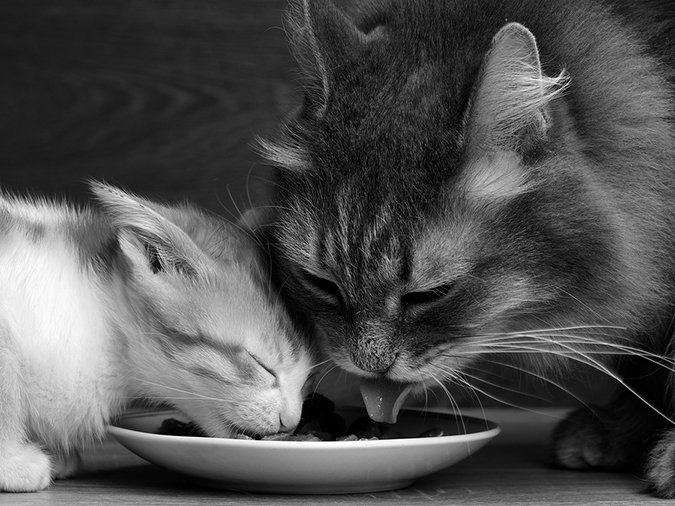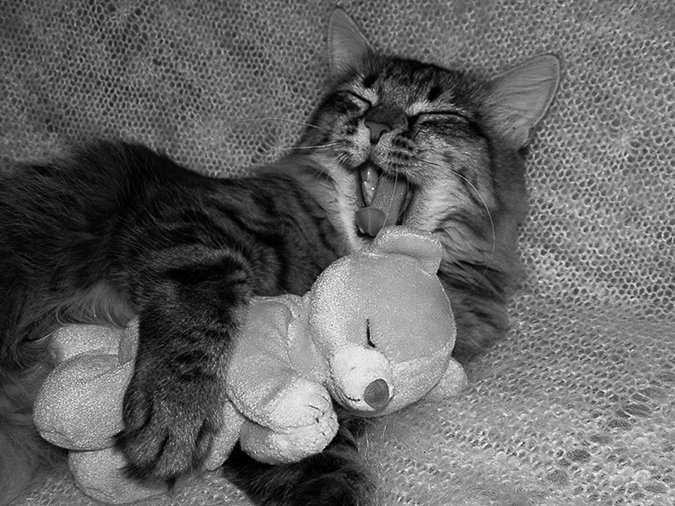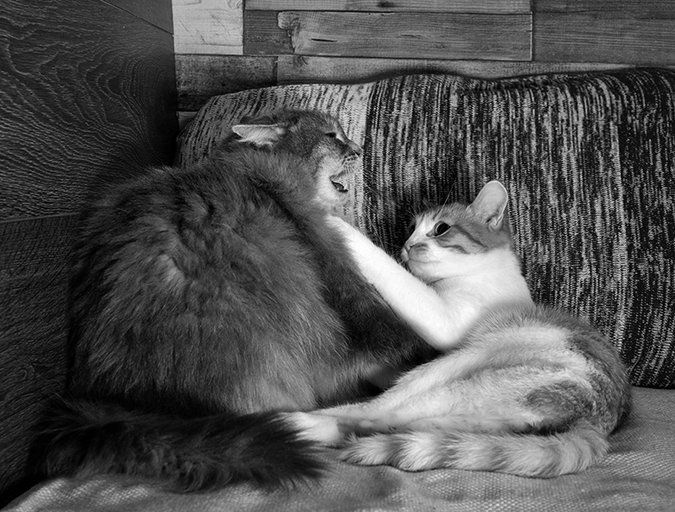You see your indoor cat purring, even cackling while nestled on a window perch, eying the birdhouse on a tree limb in your back yard. But he suddenly becomes agitated and then angry when your other cat dares to share his window perch. Your otherwise sweet cat taps into his wild ancestry as he stalks, hisses and swats the other cat who dashes to another room.
© kozorog | Bigstock

Your cat is probably exhibiting his territorial nature that has been genetically hardwired for countless generations. Like his ancestor, Felis lybica, the African wildcat, your cat will aggressively defended his turf, toys, food, bedding and even favorite people inside your home he regards as coveted resources.
It is important to recognize that cats are solitary hunters who spend much of their day searching for hunting opportunities in their environment. They feel the need to protect themselves from perceived dangers.
“Resource guarding stems from the normal desire to maintain access to valuable resources,” says Pam Perry, DVM, Ph.D., a resident in behavior at Cornell University College of Veterinary Medicine. “It involves threatening behavior directed toward any individual — human or animal — that approaches the cat while he is in possession of or near something he does not want to relinquish.”
Resource guarding arises from underlying anxiety, so, when your cat displays aggressive behavior — hissing, swatting and attacking — and the person or animal backs away, the resource guarding behavior becomes negatively reinforced. Without proper intervention, it can become your cat’s go-to behavioral response. “Resource guarding is considered a type of aggression because it involves threatening behavior directed toward an individual,” Dr. Perry says.
The 4 Top Targets in Resource Guarding Cats
By addressing your cat’s physical and emotional needs, you can reduce his resource guarding tendencies and bolster his health and quality of life. A cat’s resources should be located in areas of the home that have at least two ways for a cat to enter or leave and they should not be in areas where a cat may feel threatened or stressed.
Here are key resource guarding concerns and ways to work with them:
Resource: Litter box
Basis: It can be a site of aggression — not as much as a resource to guard as an easy place for a cat to ambush another cat when the latter is in a vulnerable position.
Behavior: One cat in the house may lie down across the hallway, blocking access to the room where the litter box is located. The cat may also hide and then pounce on the other cat while using the box or when he exits it, scaring him away and potentially making him reluctant to use it again.
Possible solutions: Locate litter boxes in different rooms to prevent the resource-guarding feline from being able to block access. He can’t be in two places at one time. Make sure your cats can view any possible threat easily while in a litter box, so that may mean not having hooded litter boxes that block their view. Remember, the recommended number of litter boxes is one per cat plus one. So, if you have three cats, you should have four litter boxes located in different rooms to minimize resource guarding behavior.
© zastavkin | Bigstock

Resource: Cat furniture tree or scratching post
Basis: Cats feel safe when they can survey their environments from a high, sturdy place. They also need to mark their territories by releasing scent from glands in their claws when they scratch on surfaces like cat trees.
Behavior: One cat will be lounging or even sleeping on the cat furniture when a second leaps up and attempts hissing, swatting or body positioning to take over that spot. Or a cat will block access for another cat to scratch a post.
Possible solutions: Increase the number of cat trees, scratching posts and position them in different rooms. These measures can aid in shifting your cat’s mindset of scarcity of resources to one of abundance.
Resource: Food bowl
Basis: Some cats who are more food motivated may be more apt to resource guard at mealtimes, especially when food is being prepared.
Behavior: One cat may quickly gulp his food and then push another cat away from his bowl. Or he may block the entrance to the kitchen while you prepare the meals. He may hiss or even attack the other cat when food is present. An intimidated cat may hide and wait until the bully cat leaves to enter the kitchen and attempt to eat his meal. And some cats may swat or bite a person if they perceive that person will take the food away before they’ve finished eating.
Possible solutions: In multi-pet households, feed the pets in separate areas of the kitchen or even different rooms so that they can enjoy eating meals at their own pace without the threat or fear of not being able to finish. Quietly position yourself between the two food bowls to block direct eye contact between the cats. Help your cat feel mealtime is safe by refraining from sticking your hands in the food dish or taking the dish away while your cat is eating. Occasionally, swap out food bowls for food puzzles to encourage your cat to earn his food by hunting.
Resource: Favorite cat toy
Basis: The toy contains the cat’s scent and has been a dependable resource for play, making it a valuable commodity for the cat.
Behavior: “I have seen my kittens growl at each other if they have a favorite toy or a mouse that another tries to take,” says Dr. Perry.
Possible solutions: Disrupt the interaction before it escalates into aggression by calling them away from the toy. Then with the cats separated, engage them in play with separate toys. Also, store and rotate toys and schedule mini-play sessions.
Your Cat’s Perspective
The severity can range from tensing muscles and hissing to lunging and biting. Keep in mind that cats mark what they deem to be their resources by rubbing their faces and bodies on these items. This action releases natural pheromones. Some cats feel so stressed and threatened that they will urine spray to mark their territory as a scent warning to others to back off. “The value of an item will vary between individual cats,” says Dr. Perry. It’s important to understand “core” resources from your cat’s perspective.
© Noam Armonn | Bigstock

To minimize resource guarding in a multi-pet household, strive to create a healthy feline indoor environment. Do not yell at or physically punish your resource-guarding cat because this punitive approach will cause him to want to protect his resources even more and it can damage your relationship with him. While resource guarding is less common in cats than in dogs, it can escalate into a serious behavior issue that requires intervention by a professional.
Here are the key ways to meet the needs of your indoor cats in order of priority as identified by the American Association of Feline Practitioners. You should provide:
A safe place. Each cat needs a safe, secure place where he feels protected. These may include an open pet carrier, a cardboard box or a raised cat perch.
Multiple and separated key environmental resources in multi-pet households. These include food, water, litter boxes, scratching areas, play and sleeping areas. These resources should be separated from each other so that cats have free access without being challenged by other cats or pets in the home. Separation of resources reduces the risk of competition as well as stress-associated diseases.
Opportunity for play and the chance to display predatory behavior. Cats need to be able to capture “prey” during play. Using food puzzles can also mimic the action of hunting for prey. Be sure to rotate your cat’s toys so he doesn’t get bored.
Positive, consistent and predictable human-cat social interactions. Keep in mind that each cat has personal preferences regarding how much human interaction (petting, grooming, being played with or picked up) they can tolerate. Remind guests not to force interaction and instead allow your cat to initiate, decide and control the encounter with them.
An environment that respects the importance of a cat’s sense of smell. Cats use their sense of smell to evaluate their surroundings. Threatening smells to cats include scented products, cleaners or detergents as well as the scent of unfamiliar animals.
A cat is likely to guard a resting spot near a favorite human because he regards this person as a scarce resource to be coveted and not shared. That includes you and other family members. Be forewarned that the cat may hiss or swat at an approaching cat or the family dog who also wants to be on the person’s lap or share the sofa with them.
Stand up and leave the room at the early signs of your cat showing irritation as another pet enters the room. This removes your cat’s prized resource — your lap. Consider spending one-on-one time with each pet in closed rooms so each gets his share of attention.



